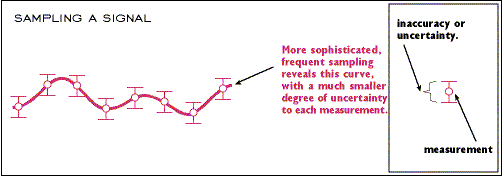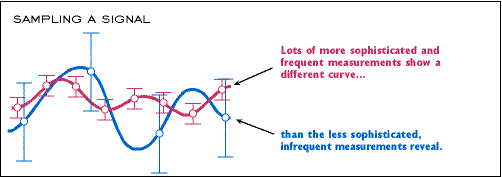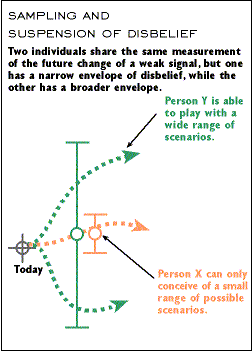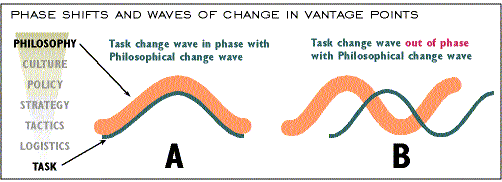
Weak Signal® Research
Part III: Sampling, Uncertainty and Phase Shifts
in Weak Signal Evolution
Bryan S. Coffman
January 21, 1997
back to Part I: Introduction
back to Part II: Information Theory
Overview
Sampling refers to the manner in which
weak signals are searched for and studied. Uncertainty pertains to the
ability of the organization to broaden the scope of possible scenarios
it can willingly entertain for the future of particular weak signals.
The section on phase shifts introduces the challenge of keeping different
vantage points within the organization requisite with one another while
implementing efforts to take advantage of possible weak signal scenarios.
Sampling
Recall from Part I that from the enterprise's point of view, a weak signal
may be a single instance of communication of some novel idea or process.
More often, however, the "weak signal" may not be one individual
signal at all, but a number of signals transmitted over time and from
different sources across various channels. The receiving organization
must have Associator algorithms for sorting through all of this and revealing
the patterns that will indicate something novel and valuable on the horizon.
Communications engineers would argue that I'm talking about multiple signaling
events, not just a single one, and therefore the term "weak signal"
does not literally apply. That's correct; I'm using the term metaphorically
with respect to the enterprise. This section on sampling, uncertainty
and phase shifts will exhibit diagrams showing a "signal" propagating
through some medium over time. It should be understood that I'm now looking
at a series of communications over time, probably from various sources,
and treating them as if they were part of one intermittent communication
event. And not only an event whose timeline lies in the past only, but
extends out into the future as well. For though we're interested in the
history of weak signals, the money is bet, made and lost on the future.
This means that we're interested in the shape of the curve:
is it rising, falling, stable? How fast is it changing? Is it's long term
behavior cyclic? If so, when will the next cycle begin and end?
Investment in Weak Signal Research
If we were investigating the shape of real electrical signals, we would
choose a piece of equipment to track and map the signal, and decide on
how many times per second, minute, hour we wanted to sample the signal
with our equipment. In other words, how much time do we want to devote
to paying attention to the signal, and what degree of sophistication do
we wish to bring to the task?
The more sophisticated the equipment, the greater the accuracy
we'll get in each measurement we take (how high or low the signal is at
that instant). The more samples per unit of time that we take, the better
sense we'll get of the shape of the signal--its rise, fall and its period
if it's cycling.
Here's a simple diagram showing the use of relatively unsophisticated
equipment on an infrequent basis.

Notice that, although I've drawn a curve connecting the
midpoints of each measurement, there's a great deal of uncertainty concerning
the actual position of the curve at any moment in time. All that the four
measurements really reveal is that the curve rises, falls and then begins
to rise again.
Here's a diagram showing the use of sophisticated equipment
and frequent sampling of the same signal.

These samples reveal a much different shape to the curve--something
much less volatile. If the amplitude of the curve were critical to decision
making, then the first sampling technique would have completely missed
the mark and the organization would have scrambled around for no reason.
Finally, a diagram showing the two curves superimposed for
comparison.

Getting the "Equipment"
Together
A communications engineer presumably can refer to a catalog for a list
of equipment to do his scanning with. There will also be a budget of some
sort that will constrain the time that can be devoted to the activity.
But what about the enterprise that wants to seriously engage in weak signal
research? The budgetary issues are straightforward, but what is the metaphorical
equivalent of the equipment?
The equipment consists of all of the subsystems required
for processing messages and assigning value to them so that they become
information. For a complete description of these sub-systems, refer to
Miller's Living Systems model. But I'll mention
a few here: the Input Transducer, Decoder, and Associator.
The Input Transducer is the eyes of the organization. It
includes not only the technical means of "seeing" signals in
the environment, but also determines what it is POSSIBLE to see. Remember
that this subject was discussed
in Part II.
The Decoder changes signals into messages. Think about the
text on this page that you're viewing. You're using Input Transducers
to see the letters. But if you did not know English, you could not decode
the letters into words and sentences. The Decoder executes this function
and makes it possible for the Associator to do its work further down the
chain.
The Associator is the model
builder of the organization. It sorts through all of the messages and
assembles them into patterns based on an accepted library stored in Memory.
These patterns represent value or meaning to the organization and are
used to influence behavior so that the organization can thrive.
An enterprise can concentrate on these three areas alone
to develop a good design for creating a culture and policies that encourage
weak signal research. The following matrix includes some questions to
ask during the design process.
| |
People |
Tools and Processes |
Environment |
| Input Transducer |
Who's good at sensing the outside environment,
and what skills can be passed on to others? |
What routine and non-routine mechanisms
are employed to search out new messages from the environment?
What implements are used? And what channels are investigated? |
All of these activities take place somewhere
in real space or cyberspace. The combination of furniture, lighting,
accessories, equipment such as monitors, etc. can strongly influence
the success or failure of a weak signal research program. Environments
invite us unconsciously to certain activities. Courtrooms, churches,
libraries, theaters all influence behavior by the cultural values
that are built into their architectural features. |
| Decoder |
Who understands the basic content of
diverse messages from the environment, most of which will not
be in the language of the enterprise or its industry? |
Who are the subject matter experts?
What's the process for learning about things you don't understand?
How is such investigation welcomed and supported? |
| Associator |
Who's good at assembling diverse sets
of messages into compelling scenarios or stories, augmented by
simulations, illustrations and diagrams? |
What modeling tools are used? Simulators
(not just software-based, but real life immersions as well). How
is every associate in the enterprise taught to execute the role
of the Associator? |
SETI
The Search for ExtraTerrestrial Intelligence project is an interesting
case study for conduction weak signal research, and also for how this
research is changing in method and mode. Once a federally-funded, centrally
controlled project, it has had to innovate in order to survive. Now, for
a few thousand dollars, anyone can purchase the equipment that allows
them to scan a portion of the sky in the search for weak signals that
might indicate an intelligent source. The equipment is not terribly difficult
to learn to operate and the project will help individuals get up and running,
stay connected, and coordinate their efforts. Chances are, as a network
the project will both survive, gain greater credibility, and possibly
more popular support. There is an article about SETI in the January issue
of Wired magazine, and the home page for the
SETI League, Inc. can be found
here.
Uncertainty and Suspension of Disbelief
Sampling really concerns gathering messages from the past so that they
can be aggregated and modeled in a search for value and meaning. The modeling
undertaken by the Associator, however implies making projections into
the future. This is best done via simulation and scenario building.
 In the diagram to the left, I'm using the
same symbols that were used above to indicate the accuracy of a measurement.
In this diagram, though, they stand for a measure of the creative playfulness
of the modeler. In the diagram to the left, I'm using the
same symbols that were used above to indicate the accuracy of a measurement.
In this diagram, though, they stand for a measure of the creative playfulness
of the modeler.
In the diagram, both of the people tend to believe that
the future of the weak signal lies along the path indicated by the green
and orange circles. There the similarity ends. Modeler "X" believes
not only that his estimate of the future is right, but is extremely confident
in that estimate--he admits little or no uncertainty. Predictions outside
of this narrow envelope of possibilities are met with dismissal. It's
important to note that X's beliefs are probably supported by a great deal
of historical precedent and experience and by perhaps very sophisticated
models. Modeler "Y", on the other hand, is quite able to suspend
disbelief concerning the path that a certain set of weak signals might
take, and investigates possible paths well away from what he believes
the most probable path to be. He says to himself, "if such a divergent
path were true instead of the most probable path, what else--in a non-linear
way--would I have to look for as validation? In other words, he formulates
a hypothesis and then sets out to search for other messages in the environment
that corroborate (or deny) it. He will find both affirmation and denial
because trends in human affairs are not quite as tidy as they are in more
scientific fields of study. The challenge then is to build convincing
scenarios given that the hypothesis is true, and then investigate the
costs and benefits of redesigning the enterprise with the flexibility
to respond to this possibility, should it actually occur.
I'm not implying that modelers and Associators engage in
purely fanciful journeys into the imagination (although some of these
might prove at least as accurate than the traditional numerical, linear
forecasting methods). There should be a discipline brought to the process.
This is not a casual brainstorming method, but rigorous research. After
disbelief is suspended for the purpose of building scenarios, and the
scenarios have been completed, they should be examined and evaluated,
and neither casually accepted or rejected.
Phase Shifts in Waves of Change
An enterprise--from society to company to individual--can be thought of
from seven different Vantage Points from Philosophy to Task.
Assume that the enterprise has accepted a weak signal scenario and is
at work to implement changes to its structure, processes, tools and environment
to capitalize on the scenario (actually, to promote its occurrence). This
acceptance is usually made at the Policy or Strategy level, and propagates
up and down the model from there. The shifts implied in such a change
usually creates stresses in the enterprise, and one or more of the vantage
points can get out of phase, or out of cycle with the rest. For example,
Philosophy may lag Tasks, as shown in "B" of the diagram, below.

Here's an illustration. The number and type of tasks required
for an individual to know in order to maintain his or her house today
prohibits most of us from accomplishing the feat. In fact, it prohibits
most of us from even understanding enough of the issues to make an intelligent
decision when offered conflicting solutions from subcontractors and repair
people. Yet there is a persistent philosophical undertone that still glorifies
the ability of a man or a family to be self-sufficient in this area. What's
missing are the intervening logistics, tactics, strategies, policies and
culture that would allow the tasks to be brought into phase with the philosophy.
The same difficulty can occur in organizations. And it can
also occur in the broader society. Often, the cause of the problem is
a growing ecosystem of new weak signals that are causing one of the vantage
points to shift out of phase. The Internet--no longer a weak signal by
any means--has so changed the logistics of publishing as to cause disruption
up and down the model. It was fine for speech to be free as long as certain
constituencies managed the vast majority of signals, channels and messages.
Now that anyone with a few dollars can publish nearly anything, all sorts
of philosophical and cultural norms are being challenged. Everyone's engaging
in various strategies and tactics to develop policies to sway things one
way or another. And there's a great focus on tasks as well--encryption,
anonymous E-mail, sting techniques. All of this--despite the personal
feelings you may have about it--is for the purpose of sorting things out
so that the seven vantage points may come back into phase. When the vantage
points are in phase, they have the greatest potential to amplify each
other (instead of dampening each other out) and thus present the strongest
front and generate the most steady profit. Organizations that have their
vantage points in phase are resilient. Organizations that can systematically
set their vantage points out of phase and then bring them back into phase
for the purpose of innovation and radical improvement are evolutionary.
Being in phase is not necessarily pleasant for the individuals
living in the envelope of a certain set of vantage points. After all,
the "easiest" no-brainer way to bring the vantage points into
phase is to dictate them and ruthlessly enforce them. So, Isaac Asimov
writes in his book Foundation, "Violence is the last resort
of the incompetent." As long as they remain in phase, no matter what
the suffering, the vantage points have the ability to reinforce one another.
Therefore, even a people in fairly austere circumstances may vigorously
resist change.
Part IV: Evolution and Growth
of the Weak Signal to Maturity
Part V: A Process Model for Weak Signal
Research
Other material on Weak Signal Research on this website
 
copyright © 1997, MG Taylor Corporation.
All rights reserved
copyrights,
terms and conditions
19970121220121.web.bsc
|

